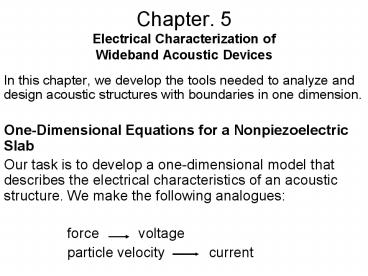Chapter' 5 Electrical Characterization of Wideband Acoustic Devices - PowerPoint PPT Presentation
1 / 34
Title:
Chapter' 5 Electrical Characterization of Wideband Acoustic Devices
Description:
In this chapter, we develop the tools needed to analyze and design ... 5.6 Draw the equivalent Mason model circuit of the stacked crystal filter (Figure 5.9((f) ... – PowerPoint PPT presentation
Number of Views:40
Avg rating:3.0/5.0
Title: Chapter' 5 Electrical Characterization of Wideband Acoustic Devices
1
Chapter. 5Electrical Characterization of
Wideband Acoustic Devices
- In this chapter, we develop the tools needed to
analyze and design acoustic structures with
boundaries in one dimension. - One-Dimensional Equations for a Nonpiezoelectric
Slab - Our task is to develop a one-dimensional model
that describes the electrical characteristics of
an acoustic structure. We make the following
analogues - force voltage
- particle velocity
current
2
(one-dimension, propagating in z-direction)
The particle displacement u may be either
z-direction (longitudinal) or normal to the
z-axis (shear)
3
Now consider a finite slab bounded by the planes
zz1, and zz2 as shown in the following figure.
4
The interaction of these waves causes the
resonance conditions that dramatically alter the
electrical characteristic of acoustic devices.
At the left boundary (zz1),
At the right boundary (zz2),
5
Form (1) (2)
the thickness of the slab
6
Now at boundary ,
7
Likewise, at
8
using
9
(No Transcript)
10
(No Transcript)
11
One-Dimensional Equations for a Piezoelectric Slab
For a piezoelectric slab of thickness b, there is
an extra term relating the coupling between the
electrical and acoustic fields.
12
In the above figure (a) the electrical conditions
imply that D, and not E, is constant. The
displacement vector is constant because (inside
the piezolayer)
In one dimension, we have simply that D is
constant in z. The case in which E is constant in
z is shown in figure (b).
13
The presence of (instead of )
results in the requirement of rather
than in description of coupling in the
piezoelectric slab with thickness excitation.
In the piezolayer, the current is purely a
displacement current.
static or clamped capacitance
14
The current in the piezoelectric is composed of
two terms
1).The displacement current through a
capacitance,
- 2).The current due to the conversion of
mechanical energy,
Now from
we can get
and
15
The equivalent circuit of a piezoelectric slab is
shown below
16
From the above equation
Comparing with
We know the turns of the transformer ( ) is
just hC0.
Thus, the voltage is
17
(No Transcript)
18
(No Transcript)
19
If h 0, then the secondary of the
transformer is short circuited and
0. There is thus no current in the primary, and
the circuit reduces to a simple capacitor with
Impedance given by the familiar expression
20
(No Transcript)
21
(No Transcript)
22
Closed-Form Expression for the Input Impedance
In general, it is not possible to obtain a
closed-form solution for the electrical
impedance, due to the complexity of the
various layers in the Mason mode. Each
nonopiezoelectric layer is represented by a 2x2
matrix, where as the piezolayer requires a 3x3
matrix as follow.
23
In two cases, however, it is possible to obtain
closed-form solution. One case is a piezoelectric
resonator that is stress free on either side (no
metallic or substrate layers).
The second, somewhat more complex, case is a
structure consisting of a combination of a
piezoelectric body catenated
with a nonpiezoelectric body.
1). A piezoelectric resonator that is stress free
on either side.
24
using (1) and (2), we can solve and
in terms of I as follows.
25
and
26
resonance parallel resonance Max impedance
series resonance Max admittance
2). A piezoelectric slab catenated with an
infinite substrate, which support only one
wave traveling to the right. Boundary
conditions
27
(No Transcript)
28
resonance, antiresonance, the ratio of
program2
29
(No Transcript)
30
(No Transcript)
31
(No Transcript)
32
(No Transcript)
33
PROBLEMS
5.1 Find the required transducer area for a
ltygt lithium niobate transducer ducer on
gallium phosphide lt1,1,0gt that is operate in the
third harmonic at 1 GHz. The properties of
the substrate are 4.13 and 6.3x
5.2 Let Write the acoustic
component of the input impedance in
closed form. What are the resonance conditions?
5.3 Repeat Problem 5.1 for the fifth harmonic.
5.4 Plot the functions and
for the acoustic impedance ratios
.5,1,and 2.
5.5 Discuss the performance of the following
acoustic structure
LiNbO3
SiO2
SUBSTRATE
34
5.6 Draw the equivalent Mason model circuit of
the stacked crystal filter (Figure
5.9((f)).
5.7 Write a computer program to find the
electrical input impedance of the infinite
delay line structure (see (5.51)).































